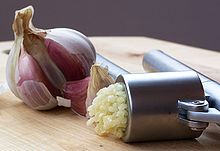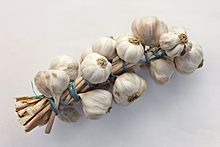 |
|
|
|
|
| Cuisines | Herbal | Spice | Curry | Yeast | Recipe | ||||||
|
Garlic Allium sativum, commonly known as garlic, is a species in the onion genus, Allium. Its close relatives include the onion, shallot, leek, chive, and rakkyo. With a history of human use of over 7,000 years, garlic is native to central Asia, and has long been a staple in the Mediterranean region, as well as a frequent seasoning in Asia, Africa, and Europe. It was known to Ancient Egyptians, and has been used for both culinary and medicinal purposes. CultivationGarlic is easy to grow and can be grown year-round in mild climates. While sexual propagation of garlic is indeed possible, nearly all of the garlic in cultivation is propagated asexually, by planting individual cloves in the ground. In cold climates, cloves are planted in the fall, about six weeks before the soil freezes, and harvested in late spring. Garlic plants are usually very hardy, and are not attacked by many pests or diseases. Garlic plants are said to repel rabbits and moles. Two of the major pathogens that attack garlic are nematodes and white rot disease, which remain in the soil indefinitely after the ground has become infected. Garlic also can suffer from pink root, a typically nonfatal disease that stunts the roots and turns them pink or red. Garlic plants can be grown closely together, leaving enough space for the bulbs to mature, and are easily grown in containers of sufficient depth. When selecting garlic for planting, it is important to pick large heads from which to separate cloves. Large cloves, along with proper spacing in the planting bed, will also improve head size. Garlic plants prefer to grow in a soil with a high organic material content, but are capable of growing in a wide range of soil conditions and pH levels. There are different types or subspecies of garlic, most notably hardneck garlic and softneck garlic. The latitude where the garlic is grown affects the choice of type as garlic can be day-length sensitive. Hardneck garlic is generally grown in cooler climates; softneck garlic is generally grown closer to the equator. Garlic scapes are removed to focus all the garlic's energy into bulb growth. The scapes can be eaten raw or cooked. Culinary uses Garlic is widely used around the world for its pungent flavor as a seasoning or condiment. The garlic plant's bulb is the most commonly used part of the plant. With the exception of the single clove types, garlic bulbs are normally divided into numerous fleshy sections called cloves. Garlic cloves are used for consumption (raw or cooked) or for medicinal purposes. They have a characteristic pungent, spicy flavor that mellows and sweetens considerably with cooking. Other parts of the garlic plant are also edible. The leaves and flowers (bulbils) on the head (spathe) are sometimes eaten. They are milder in flavor than the bulbs, and are most often consumed while immature and still tender. Immature garlic is sometimes pulled, rather like a scallion, and sold as "green garlic". When green garlic is allowed to grow past the "scallion" stage, but not permitted to fully mature, it may produce a garlic "round", a bulb like a boiling onion, but not separated into cloves like a mature bulb. Additionally, the immature flower stalks (scapes) of the hardneck and elephant types are sometimes marketed for uses similar to asparagus in stir-fries. Inedible or rarely eaten parts of the garlic plant include the "skin" and root cluster. The papery, protective layers of "skin" over various parts of the plant are generally discarded during preparation for most culinary uses, though in Korea immature whole heads are sometimes prepared with the tender skins intact. The root cluster attached to the basal plate of the bulb is the only part not typically considered palatable in any form. Garlic is a fundamental component in many or most dishes of various regions, including eastern Asia, South Asia, Southeast Asia, the Middle East, northern Africa, southern Europe, and parts of South and Central America. The flavour varies in intensity and aroma with the different cooking methods. It is often paired with onion, tomato, or ginger. The parchment-like skin is much like the skin of an onion, and is typically removed before using in raw or cooked form. An alternative is to cut the top off the bulb, coat the cloves by dribbling olive oil (or other oil-based seasoning) over them, and roast them in an oven. Garlic softens and can be extracted from the cloves by squeezing the (root) end of the bulb, or individually by squeezing one end of the clove. In Korea, heads of garlic are fermented at high temperature; the resulting product, called black garlic, is sweet and syrupy, and is now being sold in the United States, United Kingdom and Australia. Garlic may be applied to different kinds of bread to create a variety of classic dishes, such as garlic bread, garlic toast, bruschetta, crostini and canap? Oils can be flavored with garlic cloves. These infused oils are used to season all categories of vegetables, meats, breads and pasta. In some cuisines, the young bulbs are pickled for three to six weeks in a mixture of sugar, salt, and spices. In eastern Europe, the shoots are pickled and eaten as an appetizer. Immature scapes are tender and edible. They are also known as "garlic spears", "stems", or "tops". Scapes generally have a milder taste than the cloves. They are often used in stir frying or braised like asparagus. Garlic leaves are a popular vegetable in many parts of Asia. The leaves are cut, cleaned, and then stir-fried with eggs, meat, or vegetables. Mixing garlic with egg yolks and olive oil produces aioli. Garlic, oil, and a chunky base produce skordalia. Blending garlic, almond, oil, and soaked bread produces ajoblanco. Garlic powder has a different taste from fresh garlic. If used as a substitute for fresh garlic, 1/8 teaspoon of garlic powder is equivalent to one clove of garlic. Medicinal use and health benefits In in vitro studies, garlic has been found to have antibacterial, antiviral, and antifungal activity. However, these actions are less clear in vivo. Garlic is also claimed to help prevent heart disease (including atherosclerosis, high cholesterol, and high blood pressure) and cancer. Garlic is used to prevent certain types of cancer, including stomach and colon cancers. Animal studies, and some early research studies in humans, have suggested possible cardiovascular benefits of garlic. A Czech study found garlic supplementation reduced accumulation of cholesterol on the vascular walls of animals. Another study had similar results, with garlic supplementation significantly reducing aortic plaque deposits of cholesterol-fed rabbits. Another study showed supplementation with garlic extract inhibited vascular calcification in human patients with high blood cholesterol. The known vasodilative effect of garlic is possibly caused by catabolism of garlic-derived polysulfides to hydrogen sulfide in red blood cells (RBCs), a reaction that is dependent on reduced thiols in or on the RBC membrane. Hydrogen sulfide is an endogenous cardioprotective vascular cell-signaling molecule. A randomized clinical trial funded by the National Institutes of Health (NIH) in the United States and published in the Archives of Internal Medicine in 2007 found the consumption of garlic in any form did not reduce blood cholesterol levels in patients with moderately high baseline cholesterol levels. According to Heart.org, "despite decades of research suggesting that garlic can improve cholesterol profiles, a new NIH-funded trial found absolutely no effects of raw garlic or garlic supplements on LDL, HDL, or triglycerides... The findings underscore the hazards of meta-analyses made up of small, flawed studies and the value of rigorously studying popular herbal remedies". In an editorial regarding the initial report's findings, two physicians from Weill Cornell Medical College of Cornell University, pointed out that there may "be effects of garlic on atherosclerosis specifically that were not picked up in the study". Allium sativum has been found to reduce platelet aggregation and hyperlipidemia. In 2007, the BBC reported Allium sativum may have other beneficial properties, such as preventing and fighting the common cold. This assertion has the backing of long tradition in herbal medicine, which has used garlic for hoarseness and coughs. The Cherokee also used it as an expectorant for coughs and croup. However, in contrast to these earlier claims concerning the cold-preventing properties of garlic, a 2012 report in the Cochrane Database of Systematic Reviews concludes that "there is insufficient clinical trial evidence regarding the effects of garlic in preventing or treating the common cold. A single trial suggested that garlic may prevent occurrences of the common cold but more studies are needed to validate this finding. Claims of effectiveness appear to rely largely on poor-quality evidence. Garlic is also alleged to help regulate blood sugar levels. Regular and prolonged use of therapeutic amounts of aged garlic extracts lower blood homocysteine levels and has been shown to prevent some complications of diabetes mellitus. People taking insulin should not consume medicinal amounts of garlic without consulting a physician. Garlic was used as an antiseptic to prevent gangrene during World War I and World War II. More recently, it has been found from a clinical trial that a mouthwash containing 2.5% fresh garlic shows good antimicrobial activity, although the majority of the participants reported an unpleasant taste and halitosis. Garlic cloves are used as a remedy for infections (especially chest problems), digestive disorders, and fungal infections such as thrush. Garlic can be used as a disinfectant because of its bacteriostatic and bacteriocidal properties. Garlic has been found to enhance thiamin absorption, and therefore reduces the likelihood for developing the thiamin deficiency beriberi.  In 1924, it was found to be an effective way to prevent scurvy, because of its high vitamin C content. Garlic has been used reasonably successfully in AIDS patients to treat Cryptosporidium in an uncontrolled study in China. It has also been used by at least one AIDS patient to treat toxoplasmosis, another protozoal disease. Garlic supplementation has been shown to boost testosterone levels in rats fed a high protein diet. A 2010 double-blind, parallel, randomised, placebo-controlled trial, involving 50 patients whose routine clinical records in general practice documented treated but uncontrolled hypertension, concluded, "Our trial suggests that aged garlic extract is superior to placebo in lowering systolic blood pressure similarly to current first line medications in patients with treated but uncontrolled hypertension." Other usesThe sticky juice within the bulb cloves is used as an adhesive in mending glass and porcelain in China. An environmentally benign garlic-derived polysulfide product is approved for use in the European Union (under Annex 1 of 91/414) and the UK as a nematicide and insecticide, including for use for control of cabbage root fly and red mite in poultry. |











